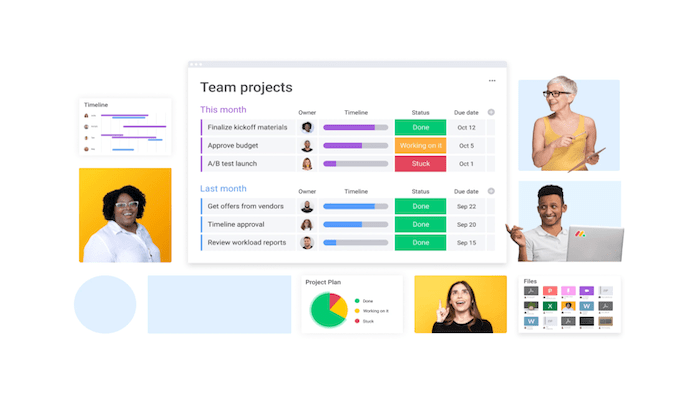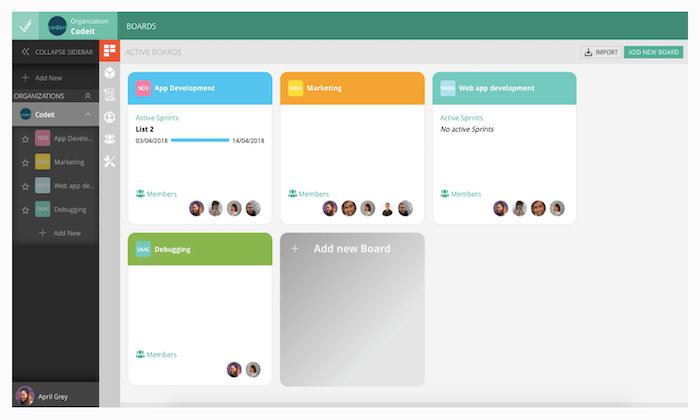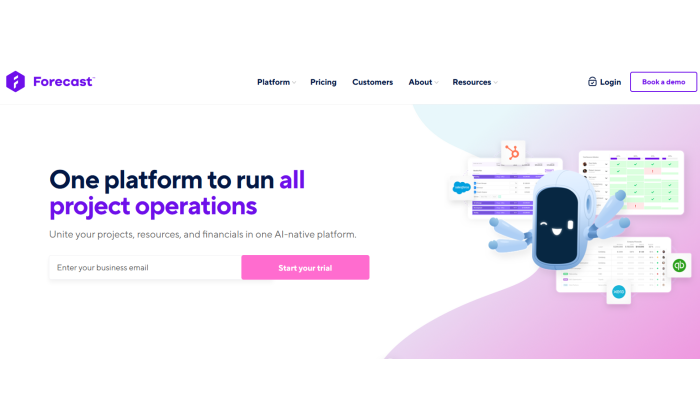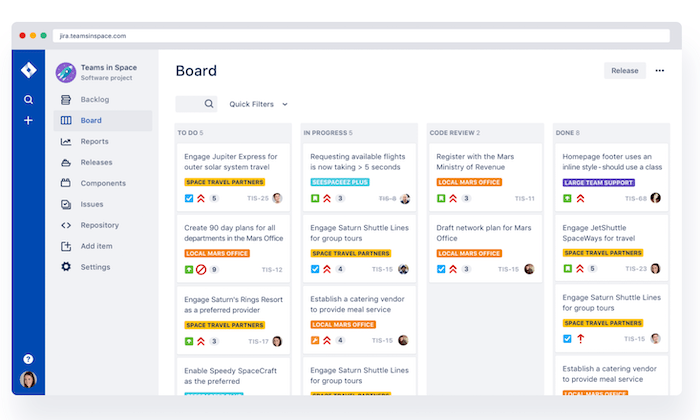
Disclosure: This content is reader-supported, which means if you click on some of our links that we may earn a commission.
Running an agile team effectively is nearly impossible without the right software.
Agile project management tools can make a big difference. Instead of trying to fit operations into an old fashioned framework, these products are purpose-built for agile workflows.
Whether you are running sprints in Scrum, working off a Kanban board, or simply trying to adopt a more agile practices at your organization, having an appropriate project management tool is key.
It will make it easier for everyone to work efficiently, communicate, and meet deadlines.
I’ve reviewed my top five picks for the best agile project management tools. The reviews are followed by a short guide that will help you evaluate my recommendations to find a solution that fits your needs.
#1 – Monday.com Review — The Best for Agile Beginners

Monday.com has quickly become one of the most popular agile project management tools on the market today. Unlike Jira and some of the other products I looked at, this isn’t just aimed at developers. Anyone who is looking to bring more agility to their organization can use Monday to get it done.
This is a great choice if you’re new to agile management and need a solution for basic projects. New users will not struggle to get a footing. If they can use Facebook, Monday will be a breeze for them.
It’s one of the easiest ways to plan, track, and deliver team projects from a single workspace. Here are some of the other reasons why I like Monday so much:
- Deploy in minutes with hundreds of customizable templates
- Integrates with tools like Slack, HubSpot, G Suite, LinkedIn, Teams, and more
- Automate repetitive tasks to save time and avoid human error
- Visual data with Kanban boards, timelines, maps, calendars, and more
- 24/7 customer support with a 10-minute average response time
- Track the progress of your projects and make data-driven decisions
- Set project goals and empower stakeholders
Monday.com makes it easy for teams to collaborate. You’ll benefit from features like file sharing, task assignments, task priorities, visual boards, and other ways to see what everyone is doing at a glance.
It’s a popular choice for remote work, marketing, creative teams, HR, sales, and more. While Monday does have tools for software development, IT, and construction projects, it’s definitely better for simple projects.
Plans start at just $8 per seat per month (with a minimum of three seats). You can try Monday.com free for 14 days with an unlimited number of users; no credit card required.
#2 – VivifyScrum Review — The Best All-in-One Agile Management Tool

VivifyScrum is a versatile agile management solution. It’s trusted by small teams and large organizations alike.
Regardless of your team size and project complexity, this tool can help manage everything from a single platform.
Here are some of the top reasons why you should consider VivifyScrum:
- Unlimited Scrum boards, unlimited Kanban boards, and unlimited items
- Custom boards with built-in team collaboration tools
- Built-in features for invoicing clients and tracking payments
- Time tracking and team management features
- Create custom workflows with agile boards
- Reporting and analytics with burndown charts, Scrum metrics, and more
The software comes with mobile apps, API access, file storage, unlimited integrations, unlimited active sprints, and so much more.
VivifyScrum starts at $49 for small teams. Contact the sales team for more information on Enterprise pricing.
#3 – Forecast Review — The Best Collaboration Features

Forecast is an all-in-one project management and resource management solution. It’s built for project-driven companies that want to empower teams, automate operations, and unite all projects into a single tool.
With Forecast, you can automate tasks for project planning, resource allocation, and more. The software is powered by AI technology to help simplify monotonous tasks.
Here are some of the top reasons and why Forecast ranks so high on my list:
- Keep the big picture in mind with real-time operational visibility
- Analyze decisions and financial health of projects
- Admins can set different permission levels for each user (clients, collaborators, etc.)
- Simple and organized backlog of project tasks
- Easy to plan sprints and track progress
- Automatically get notified about key updates in your workflow
- Continuous and fast delivery of products and tasks
Overall, Forecast has everything agile teams need to improve communication. Create and assign task cards, file sharing, dependencies, subtasks, comments, and priority lists are just a handful of examples.
It’s a popular choice for agencies, consultants, and software teams. Forecast also has solutions for project accounting and business intelligence. The software seamlessly integrates with other popular tools that your team is using.
Forecast’s AI will learn from your previous projects and suggest the number of hours that should be allocated to similar tasks.
Plans start at $29 per seat per month (with a minimum of 10 seats). Try it free for 14 days; no credit card required.
#4 – Mavenlink Review — The Best for Agile Management at Scale

Mavenlink is another all-in-one solution for project management and resource management. It’s a modern way for teams to collaborate from anywhere, which is perfect for remote work.
In addition to improving your team’s productivity on the operational end, Mavenlink provides deep insights into the financial performance of your projects and business as well.
Some of the top features, benefits, and noteworthy highlights of Mavenlink include:
- Rich insights for data-driven business decisions in real-time
- Flexible way to manage resources and project tasks
- Real-time automation tools
- See all projects at a glance with complete project portfolio view
- Easy to assess the health and status of specific projects or portfolio of projects
- Reusable templates to replicate success
- Consistently deliver projects on-time
- Improve project performance
- Extend workspace with popular integrations (Salesforce, Xero, Slack, HubSpot, etc.)
Mavenlink is great for larger teams that need to manage projects across multiple departments. This works fine if you’re just using it for a handful of projects. But it works just as well if you have a project portfolio of 500+.
For small teams and enterprises alike, Mavenlink has a plan for everyone. Rates aren’t available online, so you’ll need to contact their sales team for more information.
Try Mavenlink free for ten days.
#5 – Jira Review — The Best Agile Project Management Tool for Development Teams

Jira by Atlassian is a bit unique compared to some of the other tools on my list. This agile project management software is built specifically for software development projects.
With Jira, software teams of all sizes can plan, track, and release exceptional products.
You can get started today for free–not just a free trial. Jira is free forever for up to 10 users, which is about as big as a single Scrum team should get.
Let’s take a closer look at Jira’s top highlights for agile management:
- Plan sprints, create user stories, and distribute tasks for software teams
- Prioritize complete team’s work in context with full visibility for everyone
- Real-time visual data reporting
- Choose a pre-built workflow or create your own custom solutions
- Integrate with hundred of developer tools out of the box
- Connect software team’s work to your product roadmap
- Scrum boards, Kanban boards, roadmaps and agile reporting
Jira is arguably the safest project management tool on the market today in terms of data encryption and compliance. It integrates with 3,000+ apps in the Atlassian marketplace as well.
Software teams, look no further—Jira is the best option agile project management tool for you.
The tool is free for up to ten users. Paid plans start at just $7 per user per month. Try it free for seven days.
What I Looked at to Find the Best Agile Project Management Tools
There are certain factors that must be evaluated as you’re shopping around and assessing different tools.
By following the buying guide I’ve outlined below, you’ll know exactly what to look for and what’s important in an agile project management solution.
Agile Framework Preferences
The very first thing you need to consider is the agile framework you plan to use. For those of you who are already familiar with the concepts of agile management, you probably have a preferred methodology.
Do you want to use Scrum or Kanban? Lean? Crystal? Are you using agile framework variations such as Scrumban?
Depending on the answer, you’ll be able to find an agile tool that specializes in your preferred framework. What kind of reports are you expecting to pull? Do the roadmaps and templates line up with the way you work, or are you going to have to design stuff from scratch?
It’s worth noting that not every agile project management software supports all agile management frameworks. So make sure the options you’re considering offer the methodology you need to implement.
Collaboration Features
Team collaboration is a crucial component of agile management. You want to make sure the software you’re considering comes out-of-the-box with collaboration tools.
Most solutions should come standard with features like team tagging, comments, file sharing, and other basic tools. Some software will have more advanced features, depending on your project type, industry, and team needs.
Team Size
Just because an agile project management tool offers collaboration features, don’t assume that the tool will be robust enough for your specific team.
There are solutions on the market made for small teams with a handful of users. Those won’t be ideal for businesses that have multiple teams, hundreds of users, and multiple projects across several departments.
It should be relatively easy to determine if the tool in question is built to scale. If not, you can always express those concerns with the sales team during a free trial or demo.
Project Type
The complexity of your projects will also play a significant factor in choosing the best software for your team.
For example, software development teams and internal IT departments typically have more advanced needs since these projects have a higher level of complexity. In these cases, you should avoid beginner tools and look for industry-specific solutions tailored toward your project needs.
On the flip side, managers and teams who are just starting out with agile project management should be seeking basic solutions to manage simple projects.
Reporting
The best agile project management software will provide you with detailed reports and advanced analytics about your projects.
You can use these dashboards as a way to learn more about your team’s productivity, find out if the project will be completed on time, and if you’re staying on budget. As a project manager, this information is crucial to the big-picture operation of your business.
Usability
The usability of an agile management tool is often overlooked during the evaluation process. But it’s definitely something that needs to be taken into consideration.
What is your technical experience? How tech-savvy is your team?
If you choose a rigid solution that’s tough to use, it can do more harm than good.
So you need to find a balance between a tool that’s robust enough to handle your project complexity while still easy for your team to navigate.
This is another reason why you should always take advantage of free trials and demos as you’re narrowing down different options.
Summary
The only way to effectively manage an agile team is with the right project management tool. Which agile project management software is the best?
Let’s take one last look at all of my top recommendations:
- Monday.com — Best for agile beginners
- VivifyScrum — Best all-in-one agile management tool
- Forecast — Best collaboration features
- Mavenlink — Best for agile management at scale
- Jira — Best for development teams
Even for such a niche category like agile project management tools, there are still important differences between products.
It depends on what you’re looking for. Factors like project type, team size, and other considerations must be evaluated for you to make an informed decision.
Follow my methodology and recommendations described in this guide to find the best agile project management tools for your unique situation.






